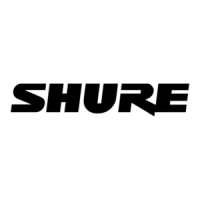9
Certifications
BLX1, BLX2, BLX4, BLX88
This Class B digital apparatus complies with Canadian
ICES-003. Cet appareil numérique de la classe B est con-
forme à la norme NMB-003 du Canada.
Meets requirements of the following standards: EN 300
422 Parts 1 and 2, EN 301 489 Parts 1 and 9, EN60065.
Meets essential requirements of the following European
Directives:
• R&TTE Directive 99/5/EC
• WEEE Directive 2002/96/EC, as amended by 2008/34/
EC
• RoHS Directive 2002/95/EC, as amended by 2008/35/
EC
Note: Please follow your regional recycling scheme for
batteries and electronic waste
BLX4, BLX88
Approved under the Declaration of Conformity (DoC) pro-
vision of FCC Part 15.
Certified by IC in Canada under RSS-123 and RSS-102.
IC: 616A-BLX4A, 616A-BLX4B, 616A-BLX4C,
616A-BLX4D, 616A-BLX88A, 616A-BLX88B,
616A-BLX88C, 616A-BLX88D
BLX1, BLX2
Certified under FCC Part 74.
Certified by IC in Canada under RSS-123 and RSS-102.
FCC ID: DD4BLX1A, DD4BLX1B, DD4BLX1C,
DD4BLX1D; DD4BLX2A, DD4BLX2B, DD4BLX2C,
DD4BLX2D. IC: 616A-BLX1A, 616A-BLX1B,
616A-BLX1C, 616A-BLX1D; 616A-BLX2A, 616A-BLX2B,
616A-BLX2C, 616A-BLX2D
This device complies with Industry Canada licence-exempt
RSS standard(s). Operation of this device is subject to the
following two conditions: (1) this device may not cause
interference, and (2) this device must accept any interfer-
ence, including interference that may cause undesired
operation of the device.
Le présent appareil est conforme aux CNR d'Industrie
Canada applicables aux appareils radio exempts de
licence. L'exploitation est autorisée aux deux conditions
suivantes : (1) l'appareil ne doit pas produire de brouillage,
et (2) l'utilisateur de l'appareil doit accepter tout brouillage
radioélectrique subi, même si le brouillage est susceptible
d'en compromettre le fonctionnement.
The CE Declaration of Conformity can be obtained from
Shure Incorporated or any of its European representatives.
For contact information please visit www.shure.com
The CE Declaration of Conformity can be obtained from:
www.shure.com/europe/compliance
Authorized European representative:
Shure Europe GmbH
Headquarters Europe, Middle East & Africa
Department: EMEA Approval
Jakob-Dieffenbacher-Str. 12
75031 Eppingen, Germany
Phone: 49-7262-92 49 0
Fax: 49-7262-92 49 11 4
Email: EMEAsupport@shure.de
LICENSING INFORMATION
Licensing: A ministerial license to operate this equipment
may be required in certain areas. Consult your national
authority for possible requirements. Changes or modifica-
tions not expressly approved by Shure Incorporated could
void your authority to operate the equipment. Licensing
of Shure wireless microphone equipment is the user’s
responsibility, and licensability depends on the user’s clas-
sification and application, and on the selected frequency.
Shure strongly urges the user to contact the appropriate
telecommunications authority concerning proper licensing,
and before choosing and ordering frequencies.
Note: EMC conformance testing is based on the use of
supplied and recommended cable types. The use of other
cable types may degrade EMC performance.
Changes or modifications not expressly approved by
the manufacturer could void the user’s authority to
operate the equipment.
Information to the user
This equipment has been tested and found to comply with
the limits for a Class B digital device, pursuant to Part 15
of the FCC Rules. These limits are designed to provide
reasonable protection against harmful interference in a
residential installation. This equipment generates uses and
can radiate radio frequency energy and, if not installed
and used in accordance with the instructions, may cause
harmful interference to radio communications. However,
there is no guarantee that interference will not occur in a
particular installation. If this equipment does cause harmful
interference to radio or television reception, which can be
determined by turning the equipment off and on, the user
is encouraged to try to correct the interference by one or
more of the following measures:
• Reorient or relocate the receiving antenna.
• Increase the separation between the equipment and
the receiver.
• Connect the equipment to an outlet on a circuit
different from that to which the receiver is connected.
• Consult the dealer or an experienced radio/TV
technician for help.

